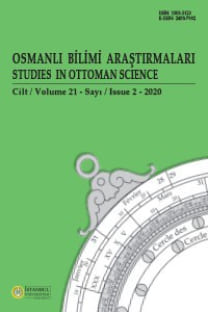Hüseyin Tevfik Paşa: ‘Lineer Cebir’in Mucidi
Linear algebra constitutes today one of the most important basic theories of modern mathematics. During the period of the curricular reform movement, also called "modern mathematics", linear algebra even replaced proper geometry teaching within the school curriculum. While comparing mathematical cultures, it might be useful to comment on developments at the “periphery”, where their innovations often go beyond the state of the art attained in the “metropoles,” even though these innovations may be noticed indirectly at best. Hüseyin Tevfik Pasha (1832-1901), educated at the ‘Mühendishane’ (Military School of Engineering) at Istanbul, was active there and in private endeavours of teaching mathematics and the sciences. His Linear Algeba saw two editions in Istanbul in 1882 and 1892. Tevfik Pasha's notion of “linear algebra” originates from an approach aiming at generalizing the notion of multiplication to lines in the two- and the three-dimensional case, thus establishing a version of vectorial calculus. His focus on Argand as his source of motivation was conditioned by the lens of reception as practiced by Tait’s school of quaternionists.
Anahtar Kelimeler:
Vidinli Hüseyin Tevfik Paşa, Lineer Cebir, matematik tarihi
Hüseyin Tevfik Pasha - The Inventor of ‘Linear Algebra’
Linear algebra constitutes today one of the most important basic theories of modern mathematics. During the period of the curricular reform movement, also called "modern mathematics", linear algebra even replaced proper geometry teaching within the school curriculum. While comparing mathematical cultures, it might be useful to comment on developments at the “periphery”, where their innovations often go beyond the state of the art attained in the “metropoles,” even though these innovations may be noticed indirectly at best. Hüseyin Tevfik Pasha (1832-1901), educated at the ‘Mühendishane’ (Military School of Engineering) at Istanbul, was active there and in private endeavours of teaching mathematics and the sciences. His Linear Algeba saw two editions in Istanbul in 1882 and 1892. Tevfik Pasha's notion of “linear algebra” originates from an approach aiming at generalizing the notion of multiplication to lines in the two- and the three-dimensional case, thus establishing a version of vectorial calculus. His focus on Argand as his source of motivation was conditioned by the lens of reception as practiced by Tait’s school of quaternionists.
___
- Argand, Essai sur une Manière de Représenter les Quantités Imaginaires dans les Constructions Géométriques. 2e éd. Précedée d’une préface par M.J. Houël et suivie d’un appendice contenant des extraits des Annales de Gergonne, relatifs à la question des imaginaires. Paris: Gauthier-Villars, 1874.
- Argand, Imaginary Quantities: Their Geometrical Interpretation. Fransızca’dan çev. Prof. A. S. Hardy [G. J. Houël’in önsözü ile.] New York: Van Nostrand, 1881.
- Kâzım Çeçen, “Introduction,” Hüseyin Tevfik Paşa ve Linear algebra. Yay. Haz. Kâzım Çeçen (Istanbul, 1988), s.13-17.
- Kâzım Çeçen (yay. Haz.), Hüseyin Tevfik Paşa ve Linear Algebra. İstanbul: İTÜ Bilim ve Teknoloji Tarihi Araştırma Merkezi, 1988.
- Gregory H. Moore, “The axiomatization of linear algebra: 1875-1940,” Historia Mathematica, c.22, 1995, s.262-303.
- Augustus de Morgan, Trigonometry and Double Algebra, Londra: Taylor, Walton ve Maberly, 1849.
- Lewis Pyenson, “Pure learning and political economy: Science and European expansion in the age of imperialism,” New Trends in the History of Science. yay. Haz. R.P.W. Visser, Amsterdam: Rodolpi, 1989, s.209-278.
- De Volson Wood, The Elements of Coordinate Geometry. New York: John Wiley & Sons, 1879.
- Gert Schubring, “Introduction – Reflections on the complex kistory of Grassmann’s reception,” ed. Gert Schubring, Hermann Günther Graßmann (1809-1877): Visionary Mathematician, Scientist and Neohumanist Scholar. Papers from a Sesquicentennial Conference, Dordrecht/Boston/London: Kluwer, 1996, s.ix-xxix.
- Gert Schubring, “Argand and the early work on graphical representation: New sources and interpretations,” Around Caspar Wessel and the Geometric Representation of Complex Numbers. Proceedings of the Wessel Symposium at the Royal Danish Academy of Sciences and Letters, Copenhagen, August 11-15 1998: Invited Papers. Matematisk-fysiske Meddelelser 46:2, Ed. Jesper Lützen, Copenhagen: C. A. Reitzel: 2001, s.125-146.
- Gert Schubring, “Il calcolo vettoriale di Grassmann,” Storia della scienza, ed. Sandro Petruccioli, Vol. VII: L’Ottocento (Roma: Istituto dell’ Enciclopedia Italiana, 2003), s.147-149.
- Hüseyin Tevfik Pacha, Linear Algebra, Constantinople, res of A.H.Boyajian, 1882.
- Hüseyin Tevfik Pacha, Linear Algebra, Second edition, revised and enlarged. Constantinople, res of A.H.Boyajian, 1892.
- Alfred N. Whitehead, Treatise on Universal Algebra with Applications, Cambridge: University res, 1898.
- ISSN: 1303-3123
- Yayın Aralığı: Yılda 2 Sayı
- Başlangıç: 1995
- Yayıncı: İstanbul Üniversitesi Edebiyat Fakültesi
Sayıdaki Diğer Makaleler
Salih Murat Uzdilek ve 'Logaritmanın Türkiye'ye Girişi'
Matematiksel Bilimlerde İlk Türkçe Dergi: Mebahis-i İlmiye (1867-69)
Hüseyin Tevfik Pasha - The Inventor of ‘Linear Algebra’
Hüseyin Tevfik Paşa: ‘Lineer Cebir’in Mucidi
Gert SCHUBRİNG, (ÇEVİREN: SEVTAP KADIOĞLU)
Kuzey Anadolu’da Amerikalı Bir Bitki Toplayıcısı: Carl Tobey (1918-1991)
Salih Murat Uzdilek ve ‘Logaritmanın Türkiye’ye Girişi'
Hüseyin Tevfik Pasha - The Inventor of 'Linear Algebra'
Prof. Kâmil Karamanoğlu'nun (1920-1976) Botanik Gezileri ve Bitki Koleksiyonu
